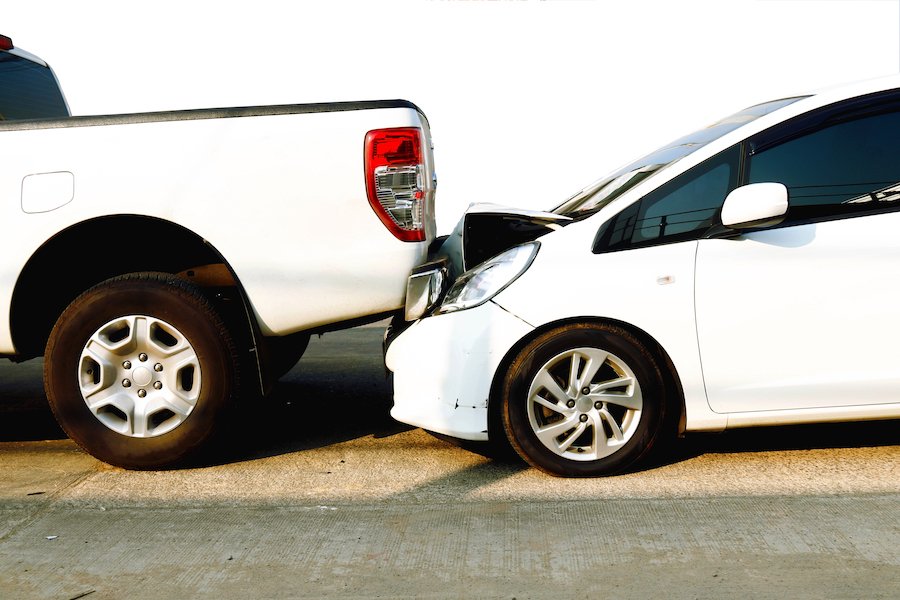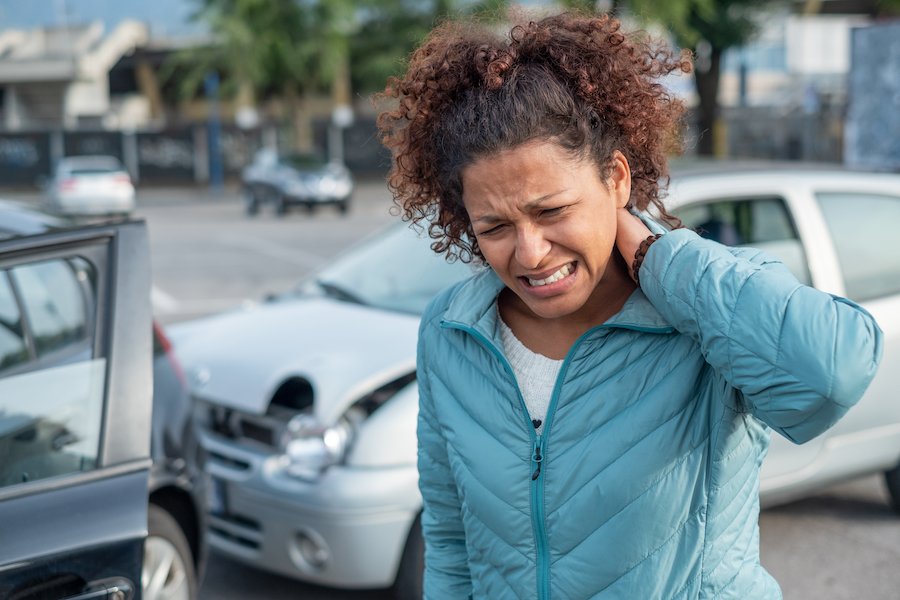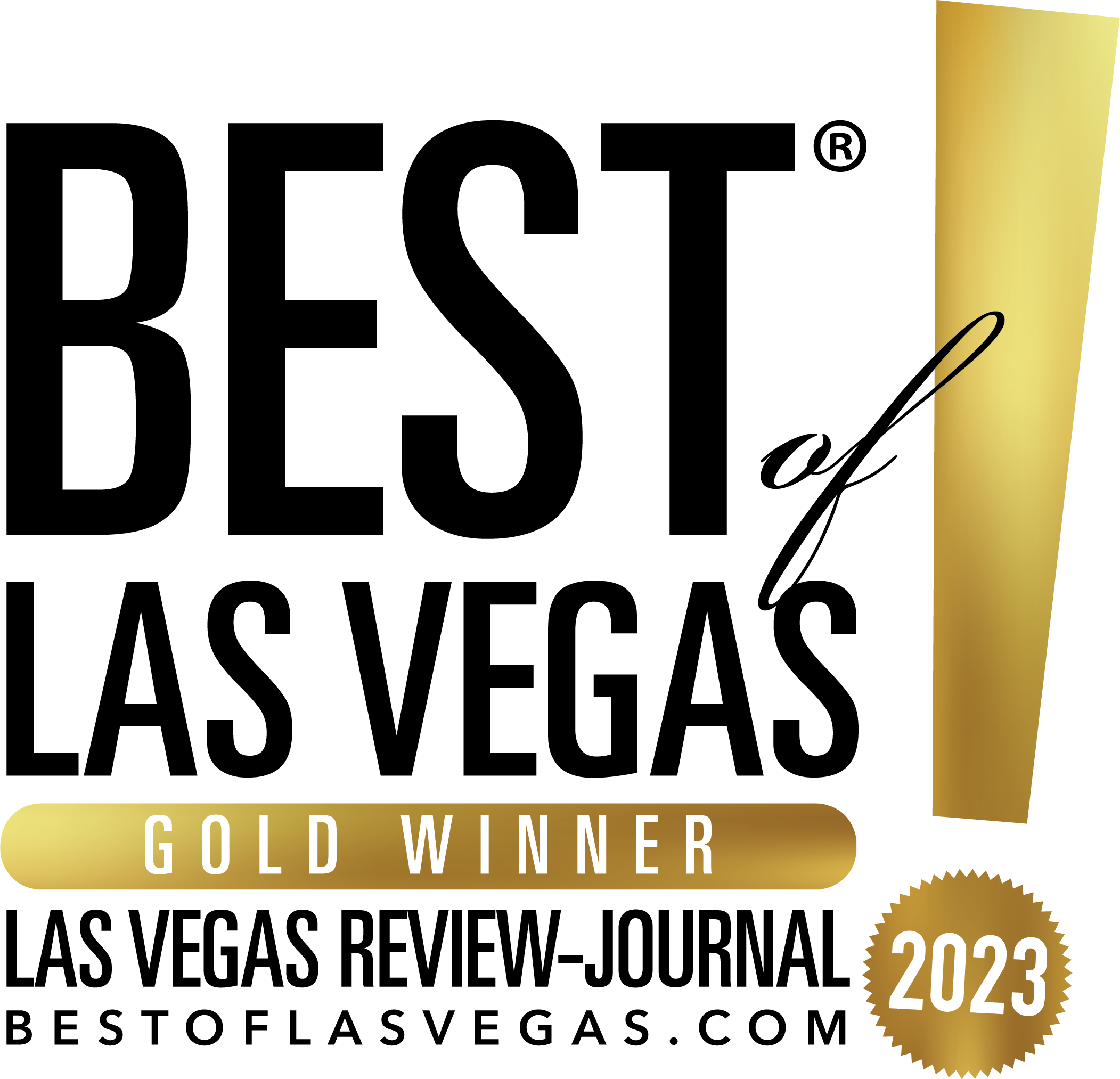Rear-end collisions are among the most common type of automobile crashes in Nevada. The cause is often a tailgating rear driver. Though the lead driver can also be negligent in Nevada by breaking abruptly or changing lanes unsafely.
If you are injured in rear-end car accident in Nevada, you may be eligible for a massive settlement to cover your:
Even if you were partly to blame for the accident, you may still be entitled to money damages as long as the defendant was at least 50% at fault.
In this article, our Nevada personal injury lawyers discuss rear-end accident lawsuits, including how to determine fault under Nevada’s comparative negligence laws and potential damages:
- 1. Who is to blame for rear-end crashes in Nevada?
- 2. What if I was partially at fault?
- 3. What money damages can I recover?
- 4. What are common rear-end car accident injuries?
- Additional reading

Tailgating is a common cause of rear-end crashes, especially in bumper-to-bumper traffic on the Las Vegas Strip and I-15.
1. Who is to blame for rear-end crashes in Nevada?
The rear driver is not always to blame in rear-end automobile collisions. In many cases, the front driver’s negligence caused — or at least contributed to — the accident.
1.1. When the front driver is at fault
A lead driver in a rear-end collision could be at fault — or partly at fault — if they either:
- cut off the rear driver with insufficient signaling and space;
- changed lanes with insufficient warning;
- stepped on the brakes instead of the gas by accident;
- knowingly drove a car with defective brakes;
- had the car in reverse by accident;
- backed up illegally (in violation of NRS 484B.113)
- had broken tail lights / brake lights;
- failed to turn on the hazard lights if the car stalled;
- stopped without warning and for no good reason; and/or
- failed to move their stalling car out of the road in a timely manner
Note that drivers who back up unsafely could share fault with the rear driver if the rear driver had been tailgating.
1.2. When the rear driver is at fault
Certainly, the majority of rear-end fender benders are the fault of the back driver. Typical reasons for these accidents include:
- tailgating (NRS 484B.127);
- distracted driving, such as committing texting while driving (NRS 484B.165);
- driving under the influence of alcohol or drugs;
- road rage;
- aggressive driving;
- speeding (NRS 484B.600); and/or
- knowingly driving with faulty brakes (or other mechanical problems)
Of all these causes, tailgating is the most common. Under NRS 484B.127, rear drivers are required to keep a prudent distance between themselves and the vehicle in front. Otherwise, the rear driver may not have adequate time and space to defuse the situation if the front vehicle stops short.
1.3. Third parties who may be at fault
Sometimes parties other than the drivers involved share the blame for causing a rear-end crash. Other potential causes of these crashes include:
- mechanical defects, which could be the fault of the vehicle’s manufacturer;
- foggy or rainy weather, which is no one’s fault unless the drivers were not driving cautiously; and/or
- poorly maintained roads, which could be the city or county’s fault;
If multiple vehicles were involved in the auto accident, the situation becomes far more complicated. Perhaps only one driver (the “trigger”) caused the pile-up, and that first driver would carry all the blame unless there were intervening causes that made the wreck worse. Or perhaps many of the involved drivers are at fault parties and share the blame.
1.4. Common evidence that proves fault
When you file a negligence lawsuit, your lawyers typically rely on such evidence as:
- eyewitness testimony and smartphone video;
- police reports;
- video surveillance (especially from cameras mounted on traffic lights);
- testimony from accident reconstruction experts (who are skilled in decoding skid marks, debris, and dents);
- medical records; and/or
- testimony from medical experts, who are skilled in determining what caused a particular injury
If a car crash case goes to trial, you have the burden to prove the defendant is negligent “by a preponderance of the evidence.” This means that it is more likely than not that the defendant was the at-fault driver.
This standard is far lower than the “beyond a reasonable doubt” standard used in criminal cases.1

About a half-million people in the U.S. are injured from rear-end car accidents each year.
2. What if I was partially at fault?
Some car crash cases are clearly the fault of one driver. Though many of the accidents result from both the lead and rear drivers being negligent.
In Nevada, a driver who partially caused a rear-end collision may still be able to sue and recover damages: The only condition is that the other driver be at least 50% at fault. Any driver that is more than 50% at fault cannot recover any damages.2
Example: Joyce is driving her car in Las Vegas, NV when she realizes she is about to miss her turn. She changes lanes really quickly without using a turn signal. This causes Julia — who happened to be speeding — to plow into Joyce. Julia sues Joyce for negligence.
At trial, the jury determines that Joyce was 60% at fault for changing lanes quickly and without a turn signal, and Julia was 40% at fault for speeding. Since Joyce was at least half to blame, Julia can recover damages from Joyce.
Although Julia in the above example will get money, it is less than what she would recover had she not been speeding. Courts reduce your financial rewards by the amount you were to blame.
3. What money damages can I recover?
If you were harmed in a rear-end accident, you may be eligible to recover compensatory damages to pay for your
- medical bills for all minor and serious injuries including medical expenses for rehab and chiropractic medical care,
- property damage to your car, which often includes not just body shop work but also repairs to your car’s electrical system, suspension system, engine, and alignment,
- lost wages for the time you are too injured to work,
- loss of future earnings if you are too injured to work, and/or
- pain and suffering (often the biggest expense)
If the victim died, their estate or family can pursue a wrongful death claim. In cases that go to trial — which is rare since most cases settle — the court can also order that the defendant pay punitive damages.
The purpose of punitive damages is to punish the defendant for reckless or malicious behavior. Punitive damages also serve as a warning to other drivers not to behave like the defendant. Plus punitive damages are often much higher than compensatory damages.3
The statute of limitations in Nevada personal injury cases can be as short as two (2) years, so be sure to contact us right away to start working on your case.
4. What are common rear-end car accident injuries?
Approximately one-third of car accidents are rear-end crashes. Each year, these accidents injure about half a million people.4 Common injuries that stem from rear-end crashes include:
- soft-tissue damage
- spinal cord injuries
- traumatic brain injuries
- broken wrists (often from smashing into the steering wheel)
- broken legs
- other broken bones/fractures
- other back problems
- lacerations on the face and head (especially if the windshield breaks)
- whiplash
- concussion (symptoms include blurred vision, confusion, headaches, ringing in the ears, and dizziness)
- abrasions
- contusions
- death
Anyone who has been in a motor vehicle accident should seek medical help as soon as possible. These medical records can serve as crucial evidence when bringing a legal claim against the culprit.
Note that not all injuries are apparent right away. Some may not manifest for days or weeks.
So consult a doctor as soon as a symptom or injury surfaces – it may be a consequence of the crash. Then you may be able to recover damages for it from the at-fault parties.
Additional reading
For more information, refer to our related articles:
- Injured in a Nevada car accident? How to bring a lawsuit
- Nevada car accident laws – Top 10 questions answered
- Is Nevada a “no-fault state” when it comes to car accidents?
- How to file a car insurance claim after an accident in Nevada
- 10 critical steps to take after a Nevada car accident
Legal References
- See also Posas v. Horton, (2010) 126 Nev. 112, 228 P.3d 457, 126 Nev. Adv. Rep. 12. See also Thomas v. Bokelman, (1970) 86 Nev. 10, 13, 462 P.2d 1020 (an intervening cause is “a superseding cause which is itself the natural and logical cause of the harm.”).
- NRS 41.141; Heric v. Christensen, (1957) 73 Nev. 6, 306 P.2d 769; see also Woosley v. State Farm Ins. Co., (2001) 117 Nev. 182, 18 P.3d 317, 117 Nev. Adv. Rep. 18.
- NRS 42.010.
- Analyses of Rear-End Crashes and Near-Crashes in the 100 – Car Naturalistic Driving Study to Support Rear-Signaling Countermeasure Development, NHTSA (October 2007)

